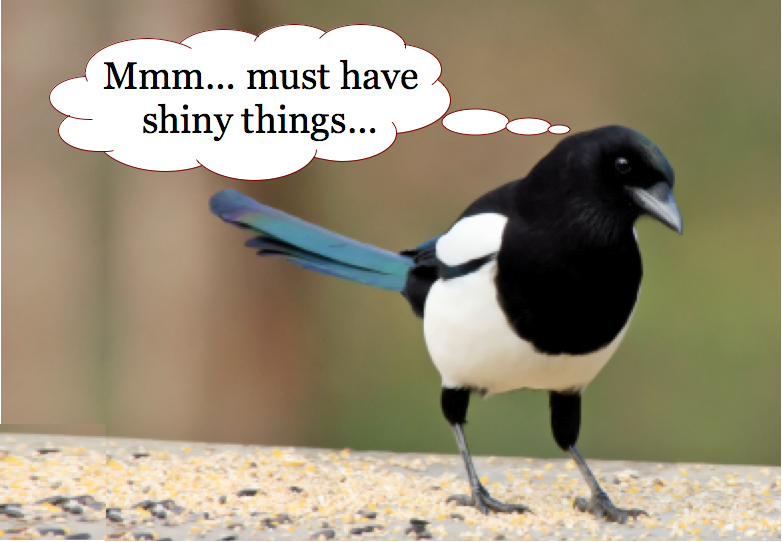Laurie's Blogs.
Sep 2016
Shiny object syndrome!

My husband once convinced me to crawl up into a tree (actually a willow bush – but ‘tree’ sounds better) to look inside a magpie nest. He had told me that looking into the nests of crows and magpies was always interesting because these birds liked to collect things. As a kid, he and his brother would do this and had found bottle caps, pop tabs, shiny rocks, pieces of twine, plastic, and various other ‘treasures’ in the nests. What did I find? Nothing! The willow bush couldn’t be climbed without destroying it… so I just had to take his word for it! Maybe only 70lb kids get to see inside of magpie nests!
But what does this have to do with your animal rehab practice? Well it actually ties in nicely with last week’s blog post about massage, manual therapy, and dry needling for neck pain. I want to talk about ‘shiny object syndrome’.
All of us have been through it. We learn a new technique, and every patient the next week is a guinea pig to practice on! Find out about a new drug, and every potential patient has it prescribed. Is that bad? Well, yes and no! For the purpose of this blog, I’m only going to talk about therapeutic techniques. (Getting all gung-ho about a new drug has the potential to be a bit more dangerous.)
Okay, so let’s say you learn acupuncture, or dry needling, or you purchase a shockwave, laser, or alpha-stim unit, or you watched one of my videos and now want to do a certain manual therapy technique. You’ll want to try it, test it, play with it, refine it, and eventually make your own decisions about it. That’s natural, and quite frankly, I think it’s good for people to assess things on their own terms and in their own hands. That’s how you learn what works for you. That’s how you differentiate between ‘hype and propaganda’ and ‘what really works’! Do this, and don’t feel bad about it!
Quite honestly, this is how I created my manual therapy courses. I went through the human techniques, studied my canine anatomy, tried things, refined things, decided what worked (and in what variation) and then wrote it down, and created the courses. Value added! Experimentation justified! Betterment for my patients and the patients of students I’ve taught!
But what happens when you get stuck on one particular theory? One guru? One technique? In this case, you limit yourself. You sacrifice the totality of wellbeing you could be offering! So lets say you take a Traditional Chinese Medicine course, and now you begin treating in this new fashion. You may find that you have great success with numbers of patients. You may find that that cases the previously stumped you are now are doing well when you address the ‘wind in their liver’. Yay! But you may still have cases that stump you! You may have cases that just don’t ‘respond like they should’! Hmmm… what do you do then? THEN, you may need to have a different set of tools. THEN, you may need to be more open-minded to other things, other ways of thinking, other therapies, and other tools!
The same thing could happen with modalities such as shockwave or laser, therapies such as massage or trigger point dry needling, techniques such as chiropractic or osteopathy, concepts such as homeopathy or traditional Chinese medicine. So what are you to do?
LEARN, PRACTICE, & TRY.
EVALUATE, DECIDE, & CONCLUDE.
And then, only then, should you formulate your opinion of when you use what and when, and why you would chose one technique, therapy, or theory over another. THAT is what makes for best patient care.
No ONE tool is a panacea. No ONE technique serves all needs. The more you can learn and the more tools you have, the more patients you can effectively serve.
So this is a bit of a rambling way of saying, ‘learn lots of different things’, ‘don’t get hung up on just one way of treating’ & ‘be open minded’!
Mic drop! Laurie out!


